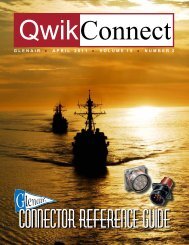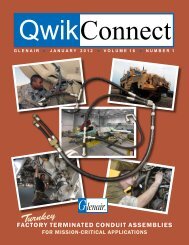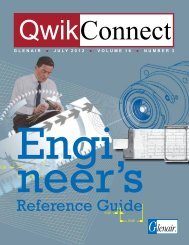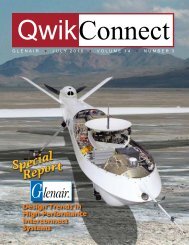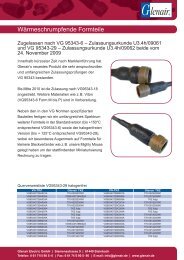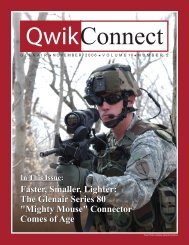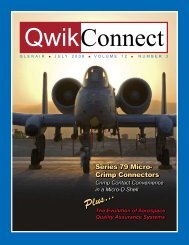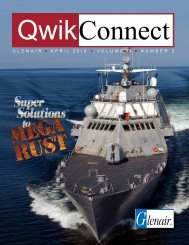RoHS - Glenair UK Ltd
RoHS - Glenair UK Ltd
RoHS - Glenair UK Ltd
Create successful ePaper yourself
Turn your PDF publications into a flip-book with our unique Google optimized e-Paper software.
the<br />
PLATING<br />
from<br />
GAME<br />
Waste a day<br />
plating Harley<br />
tail-pipes. Go<br />
back 7 spaces.<br />
Object of the Game: Improve the<br />
performance of metal and composite<br />
parts with protective electroplating.<br />
How to Play: Roll dice to begin.<br />
First player to market with all the best<br />
materials and finishes wins!<br />
START: A technician<br />
formulates solutions for<br />
use in the eletroplating<br />
“bath” by combining acids<br />
and aqueous metals to form<br />
an electrolytic liquid. These<br />
solutions contain free metal<br />
ions that will eventually be<br />
deposited onto the part<br />
via electrical current.<br />
STEP 6: Parts are then immersed in an<br />
STEP 5: After the zincate process, parts<br />
electrolytic bath of sulfuric acid and the<br />
metal plating material; and electricity is<br />
applied. The acid activates the surface of<br />
the parts, readying them to be plated. The<br />
submerged metal balls act as the anode<br />
(by giving up ions), and the parts as the<br />
cathode (by taking metal ions).<br />
are plated in an electroless nickel solution<br />
and rinsed thoroughly three times.<br />
World Cup broadcast<br />
distracts workforce.<br />
Go back to Step 4.<br />
Delivery van<br />
trailer-hitch needs<br />
chrome job.<br />
Lose turn.<br />
STEP 7: To attain specific colors, plated parts<br />
are submersed in an electroless chromic<br />
acid bath that has been dyed. The chromate<br />
solution reacts with the plating to yield colors<br />
such as olive drab, black and yellow.<br />
STEP 2: Pre-mixed batches of plating solution<br />
12 QwikConnect n January 2009<br />
QwikConnect n·<br />
January 2009<br />
are augmented with balls of sacrificial metals<br />
(in this case copper—located in hanging<br />
baskets) to provide an abundant source of free<br />
metal ions that will eventually deposit onto the<br />
connectors’ surface.<br />
STEP 4: Clean parts are<br />
stripped of all oxide buildup in<br />
a nitric acid bath, then plated in<br />
an electroless zincate solution<br />
designed to protect the surface<br />
from further oxidation.<br />
Dihydrogen<br />
mononoxide<br />
exposure.<br />
Return to start.<br />
Finish rush job on<br />
schedule. Move<br />
ahead 2 spaces.<br />
STEP 3: Raw parts are wired for<br />
electrical conductivity, thoroughly<br />
cleaned with an alkaline cleanser<br />
and an acid bath, and then finished<br />
with a sodium hydroxide “etch” to<br />
create a clean, adhesive surface to<br />
which platings can be applied.<br />
Pass NADCAP<br />
Inspection.<br />
Move ahead<br />
3 spaces.<br />
STEP 8: Plated parts receive<br />
a final rinsing in hot deionized<br />
water, after which they are<br />
dried and cured in an oven.<br />
Lastly, parts are sorted and<br />
inspectors ensure there are no<br />
flaws.<br />
FINISH!<br />
13



